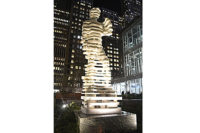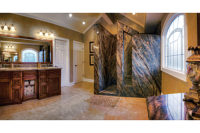

The project consists of a 25-story tower and two four-story "garden wings." All of the exterior cladding is Bethel White granite, the majority of which is being pre-assembled on galvanized steel strongback frames by Kepco+, the stone assembly and erection contractor for the project. According to Marlin Landry, vice president and Grand America project executive for Kepco+, a total of 2,800 stone-clad metal truss panels are being used for the project, totaling 175,000 square feet of materials. Additionally, 80,000 square feet of Bethel White granite is being handset.
The nominal size for the handset stone units is 1 foot, 3 inches x 2 feet, 6 inches, and the pieces are installed in a running bond pattern. A typical pre-assembled panel is 9 feet tall x 10 feet wide, and stone sizes are 2 feet, 6 inches x 5 feet. Corner pieces are 16 feet long x 4 feet x 9 feet, and in many locations, the stone has to span around sheer concrete walls at the corners.
In addition to stone panels, the architects at Smallwood Reynolds Stewart Stewart designed a series of arch openings around doorways, windows and other elements. "There were two types of arches on the job," Landry said. "The most common was the bullnose surround. There were 76 of those on the project. But the most interesting was the 'castle arch.' Ingemar [the stone fabricator] had done a castle project, and they had a replica of the arch -- which is 1 foot, 9 inches deep -- on display at trade shows. [The hotel owner] saw this arch at the Verona Fair, and he asked for details. We have eight arches like this on the job. He wanted it to look like a more intricate, cubic stone detailing than the other areas."

Owner participation
Earl Holding of Sinclair Oil Corp., the owner of the project, took a very hands-on role in the design of the project, including coordination of the stone supply. "Kepco+ made a presentation and offered to assist in budgeting and detailing, and we offered to help map out a stone selection process," Landry said. "As a hands-on owner, he wanted to buy the stone directly. Traditionally, we like to buy the stone ourselves, but my partners had worked for him before, and they knew he was determined to buy the stone himself."Before choosing a stone, the owner and the project team traveled extensively to get design ideas. "The owner wanted to visit every major U.S. city and look at buildings -- not only the stone on the building, but architectural details such as balconies, windows, doors, module sizes, corner conditions and edgework conditions," Landry said. "He put a great deal of study into it. We made eight different trips or so, and on each trip we saw two or three cities. The architects accompanied us on many of these trips, and the owner's representative, Neal Stowe, FAIA, was also there. He had been state architect of Utah, and he oversees construction on this and other Sinclair projects."
In addition to traveling around the U.S. for design ideas, the planning process also took the construction team overseas. "He made two or three trips to Europe, and two trips to Asia. He wanted to see hotels with granite cladding, and there are very few contemporary hotels in granite in the U.S.," Landry said. "He wanted an older look to the building, but it has a lot of contemporary features as well. The best place to see granite hotels of contemporary nature is Singapore, Hong Kong and Tokyo, so we made trips to those places as well."
During the early stages of the design process, the owner wanted Bethel White granite, although there was some question whether it would be used. "Salt Lake City and Utah is very much dominated by LDS Church construction, and they use a great deal of white granite in their temples. There is a temple in Bountiful, UT, that is Bethel White," Landry explained. "The problem at the time we started pre-construction was that Bethel White was unavailable in the U.S. market other than in small quantities. Rock of Ages was selling everything to Europe and the Far East at the time. So we were focusing on other materials that were close to Bethel White. We looked at some stones from Spain and Italy, and we even looked at some pinks and beiges as well as Valders limestone."
To get a feel for how the stonework would look, the design process included extensive use of mock-ups. "We recommended that [the owner] have several large fabricators build mock-ups, and we designed a mock-up for the balcony surround, which is quite detailed," Landry said. "It's a 7-foot-wide, 7-foot-tall opening, with a 6-inch recess that is stone. At the corner where the jam meets the spandrel, there is a medallion that is a 2-inch thick raised piece. All of that is raised 1 1/4 inches off the background."
Once completed, the mock-ups were taken to the jobsite. "We had six different fabricators make eight mock-ups. We put all of them on trailers, and we drove them around the site at different times of the day, so Mr. Holding could see how the stones would look at different times of the day," Landry said. "We also wanted to see how they would look with the other buildings surrounding it, and with the mountains in the background. It was quite a parade. He owned a property diagonally across the street from the project site, and we parked the mock-ups there for several months.
"Kepco+ was directed to proceed with shop drawings, but since it was the largest job in the company's history by factor of three, Mr. Holding was looking for a financial guarantee," Landry explained. "We proposed bringing in DBI as a financial partner to oversee the financial aspects of the project, so Kepco+ did the physical work, and DBI provided the desired financial guarantee to Sinclair."
Fortunately for the project, Bethel White granite became available during this course of time. "The [period of] pricing the job coincided with the economic slowdown in Asia in 1997," Landry said, adding that he had been in contact with Rock of Ages regarding another project at this time, and found that the stone would be available for the Grand America. "Already in the final negotiations with Ingemar when the Bethel White became available, Mr. Holding asked them to consider fabrication of this granite if we were able to obtain the blocks here in the States. They agreed and provided revised pricing. The blocks were shipped to Ingemar in Spain for fabrication."
According to Jon Gregory of Rock of Ages, the quarry has shipped 2,500 cubic meters (88,250 cubic feet) of Bethel White granite so far. This amounts to approximately 600 individual blocks of granite. This represents the largest single order for Bethel White granite since the late 1800s.
To complete the project, Kepco+ has a total of 80 workers in the pre-assembly plant and 30 installers on the jobsite. Construction on the tower started in June of 1998, and installation of the handset stonework began in April of 1999. The hotel is scheduled for completion in March of 2001. The project engineer is Jeremy Simmonds; the field superintendent is John Kunz; Bob Durrant was the preassembly plant manager; and Kepco+ Principals Bruce and Chris Bruce and Chris Kanaphus handled general administration of the project from Kepco+'s headquarters in Salt Lake City.
Credit Box:
Grand America HotelSalt Lake City, UT
Owner: Sinclair Oil Corp.
Architect: Smallwood Reynolds Stewart Stewart, Atlanta, GA
Architectural Consulatant: CDC, Dallas TX
General Contractor: JOJV (Jacobsen Construction/Okland Construction
Joint Venture)
Stone Assembly and Erection Contractor: Kepco+/DBI, LLC
Stone Quarrier: Rock of Ages, Barre, VT
Stone Fabricator: Ingemar, S.A., Usurbil, Spain




